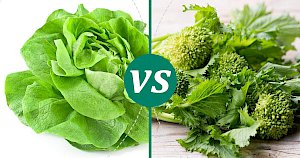Rapini vs Lettuce: Calories & Nutrition Showdown


Rapini vs Lettuce
Nutrition Facts
Serving size:
change
5g10g15g20g30g40g50g60g80g100g120g140g160g180g200g220g250g300g350g400g450g500g600g700g800g900g1000g
1oz2oz3oz4oz5oz6oz7oz8oz10oz12oz15oz20oz25oz30oz35oz40oz50oz
Amount Per Serving:
Serving size:
change
5g10g15g20g30g40g50g60g80g100g120g140g160g180g200g220g250g300g350g400g450g500g600g700g800g900g1000g
1oz2oz3oz4oz5oz6oz7oz8oz10oz12oz15oz20oz25oz30oz35oz40oz50oz
Amount Per Serving:
Rapini vs Lettuce 100g Compare
| per 100g | Rapini | Lettuce |
|---|---|---|
| Calories | 22 | 15 |
| Carbohydrates | 2.85 g | 2.87 g |
| Fat | 0.49 g | 0.15 g |
| Dietary fiber | 2.7 g | 1.3 g |
| Protein | 3.17 g | 1.36 g |
| Calcium | 108 mg | 36 mg |
| Iron | 2.14 mg | 0.86 mg |
| Magnessium | 22 mg | 13 mg |
| Potassium | 196 mg | 194 mg |
| Sodium | 33 mg | 28 mg |
| Zink | 0.77 mg | 0.18 mg |
| Vitaminium A | 2622 µg | 7405 µg |
| Vitaminium B1 (Thiamine) | 0.162 mg | 0.07 mg |
| Vitaminium B2 (riboflavin) | 0.129 mg | 0.08 mg |
| Vitaminium B3 (Niacin) | 1.221 mg | 0.375 mg |
| Vitaminium B5 | 0.21 mg | 0.134 mg |
| Vitaminium B6 | 0.171 mg | 0.09 mg |
| Vitaminium B9 (Folic acid) | 83 mg | 38 mg |
| Vitaminium C | 20.2 mg | 9.2 mg |
| Vitaminium E | 1.62 mg | 0.29 mg |
| Vitaminium K | 224 µg | 126.3 µg |
| Beta karoten | 1573 mg | 4443 mg |
Exploring the Nutritional Landscape: Rapini vs Lettuce
When it comes to selecting greens for your diet, the choices can be overwhelming. Two popular options, rapini and lettuce, offer unique flavors and nutritional profiles that cater to diverse dietary needs and culinary preferences. Rapini, also known as broccoli rabe, is celebrated for its slightly bitter taste and is a staple in Italian cuisine. Lettuce, on the other hand, is known for its crisp texture and mild flavor, making it a versatile choice for salads and sandwiches alike. Beyond their culinary uses, understanding the nutritional benefits of rapini and lettuce can help you make informed choices about your diet.
Nutritional Face-Off: Rapini vs Lettuce
At first glance, both rapini and lettuce appear to be low in calories, making them excellent choices for weight management. Rapini contains 22 calories per serving, while lettuce is even lower at 15 calories. However, the similarities end there, as each offers distinct nutritional advantages.
- Macronutrients: Rapini boasts a higher protein content with 3.17g, compared to lettuce's 1.36g, making it a preferable option for those looking to increase their protein intake from plant-based sources. Despite similar carbohydrate levels, rapini provides a more substantial fiber boost with 2.7g, promoting better digestion and satiety than lettuce's 1.3g.
- Fat Content: Both vegetables are low in fat, but rapini has a slightly higher amount (0.49g) compared to lettuce (0.15g), which may contribute to a richer texture and taste.
- Minerals: Rapini is a powerhouse of minerals such as calcium, iron, magnesium, and zinc, significantly surpassing lettuce in these categories. This makes rapini an excellent choice for supporting bone health, energy levels, and immune function.
- Vitamins: Both greens are rich in vitamins, but rapini stands out for its vitamin A, C, and K content, as well as being a good source of several B vitamins. Lettuce, while lower in these nutrients, offers an impressive amount of vitamin A, primarily in the form of beta-carotene.
What Does This Mean for Your Diet?
Choosing between rapini and lettuce ultimately depends on your nutritional needs and taste preferences. If you're seeking a nutrient-dense vegetable that can contribute to muscle maintenance and overall health, rapini is a clear winner. Its robust flavor pairs well with garlic and chili flakes, making it a delicious side dish. On the other hand, if you prefer a low-calorie, hydrating vegetable that can be used in a variety of dishes, lettuce is an excellent choice. Its mild taste and crunchy texture make it a refreshing addition to any meal.
Regardless of your choice, incorporating a variety of greens into your diet is key to obtaining a wide range of nutrients. Both rapini and lettuce offer unique benefits that can contribute to a healthy, balanced diet. So why not enjoy the best of both worlds? Experiment with these versatile greens to discover new flavors and boost your nutritional intake.
Rapini 100g
22kcalCalories source
- 40% CARBS.
- 45% PROTEIN
- 15% FAT
Lettuce 100g
15kcalCalories source
- 63% CARBS
- 30% PROTEIN
- 7% FAT
Compares of rapini
- Rapini vs Arugula
- Rapini vs Asparagus
- Rapini vs Bok Choy
- Rapini vs Broccoli
- Rapini vs Endive
- Rapini vs Fava Beans
- see all compares of rapini
Compares of lettuce
Read also:
- Calories from Rapini
- Calories of Brussels sprouts
- Calories in Butternut squash
- Cabbage calories per 100g
- Carrot protein per 100g
- How many calories does cassava have?
- Calories in a half of fodder cabbage
- Calories in whole fodder cabbage
- Calories for one, two or more fodder cabbages
- How much protein in cucumber?
Marcin Piotrowicz
calories-info.com creator
Healthy diet and healthy lifestyle promoter
Add comment